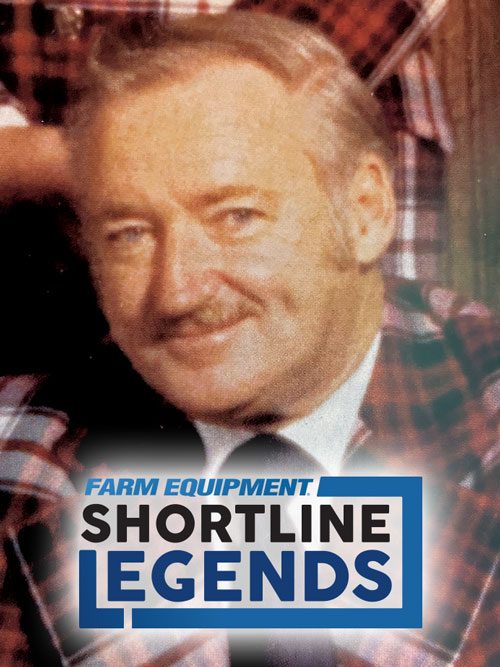Editor’s Note: While I never got the chance to meet MacDon Founder Joe MacDonald, I have long admired the Winnipeg-based manufacturer and considered it a privilege to have known Gary MacDonald for 15 or so years before his death in 2021. The article below was prepared from a variety of MacDon sources, most notably the Harvesting Performance: MacDon’s 65th Anniversary book, released to dealers in 2014 that features memories from the four MacDonald brothers (Allan, Gary, John and Scott) as well as current and retired staff.
– Mike Lessiter, Editor/Publisher
Joseph A. MacDonald’s career in farm equipment began in 1947 when he became a parts clerk at a Nova Scotia Cockshutt dealership. Before long he was promoted to Cockshutt’s head office in Brantford, Ont., where he’d earn a promotion to Canadian sales manager. When Cockshutt was purchased by White Motor in 1962, he was promoted several more times before becoming president of its Canadian division in 1970.
In 1971, his good friend Tom Killbery of Winnipeg’s Killbery Industries asked the 46 year-old MacDonald to rescue his struggling swather manufacturing enterprise, in dire straits after the extremely low commodity prices that had shocked the farm equipment business industry wide.
At the same time, the layoffs and depressed state of affairs at the recently amalgamated Cockshutt, Oliver and Minneapolis-Moline companies were tough on the “can-do spirit” of MacDonald and he accepted Killbery’s offer.
According to Tom Fox, director of engineering, the day that the Manitoba provincial government was about to take over the near-bankrupt Killbery operations, the imposing MacDonald appeared just in time. MacDonald had just quit his executive-level post, mortgaged his house, moved his family cross-country and was determined to save the company at all costs. That last-ditch effort by MacDonald in front of the “government briefcases” changed the course for farmers, dealers, fellow manufacturers and employees for generations to come.
MacDonald’s new employer made good products (and had been a pioneer in self-propelled windrowers), but was hampered by fixed expenses and falling sales. Later that year, Killbery confronted his friend with a bigger challenge — to leverage his leadership as the sole owner by buying him out.
While MacDonald didn’t have “more than the 2 quarters in his pocket,” he went to work. Each of Canada’s big 5 chartered banks turned him down as did 2 regional ones. With mere hours to go before the company’s lender planned to shut the operation down, the 8th bank he’d contacted reached out. MacDonald quickly talked a 30-year-old banker into visiting the operation, a “sales job” that may have been the most important one in the great salesman’s career.
Following the meeting, the young banker said, “I’ll back you, Joe, because a company like yours deserves to be in business and you’re the guy to do it.”
With MacDonald’s business acumen and network, and a resurgence in grain prices, the company rebounded to the point that, in 1976, the newly renamed MacDon moved into a new plant and employed 350 people, a number 7 times greater than when MacDonald took over.
OEM Business. That early bank deal foretold of MacDonald’s ability to win contracts on personality alone. Known as a businessman, marketer and visionary, MacDonald is unlike others in the inaugural class of Farm Equipment’s Shortline Legends, as he was proficient in neither engineering nor manufacturing. Instead, he hired the best and “let them run.” But in sales/marketing and relationships, he may have had no rival.
His plan for the company bearing his name was to remake it into an OEM powerhouse based on Killbery’s acclaimed swather. MacDon would not produce products under its own name and compete with larger companies like International Harvester (IH), Deere and Massey Ferguson (MF). Instead, MacDonald was convinced the company’s path to success would be to “turn competitors into partners” and supply MacDon-built equipment to OEMs.
The top customer for the swather was White Farm Equipment but it wasn’t large enough to support MacDon and had its own line of windrowers. MacDonald focused on building a state of the art swather that could interest the other major OEMs. He spotted an opportunity at MF due to the rivalries within the major’s departments (product management fighting with product engineering, for example) that were stronger than either’s rivalry with outside competitors.
With just one engineer and a dirt floor welding shop, the small startup produced a prototype that would eventually outperform MF’s own units on the “torture track.” MacDonald soon collected an order for 2,500 machines and built 1,400 in that year — and got the troubled company back on its feet.
That thriving OEM business led to supply contracts with White, Case, IH, MF, New Holland and Deere. Harvesters are big-ticket, public-facing products that are synonymous with every major-line’s reputation, and that forced young engineers to bring their A-game.
“His philosophy was you don’t get ahead in business by trying to beat the other guy for an extra dollar. You get ahead by coming up with arrangements that allow both to make the extra dollar…” – Tom Fox, MacDon’s retired director of engineering
While other manufacturers get anxious about being an invisible supplier and placing all their eggs in the OEM’s baskets, late son Gary said his dad loved it. “All these companies were competing against each other with his products.” And despite someone else’s decal and colors on the equipment, it wasn’t long before word got out among farmers that the units were MacDon-engineered and built.
Defining Moment. As successful as MacDon’s OEM partnerships were, they would also hand MacDon its biggest crisis and a test of wills. In 1986, an executive from MF, MacDon’s largest OEM partner, arrived in Winnipeg with surprising, welcome news.
The struggling MF, which had been part of a government bailout and still in desperate straits financially, told MacDonald that it wouldn’t be paying for the $13 million in equipment MacDon had been building for the last 9 months. Offering a “take-it-or-leave-it proposition,” MacDonald was told he could consign the equipment to dealers and accept payment if and when the equipment was sold.
With all the product painted, decaled and awaiting shipment, MF waited for the precise moment to leverage the MacDonalds into acquiescing.
Instead, the senior MacDonald calmly walked the man out and instantly decided he and his company’s fate. His parting words were, “Thanks, but we’re perfectly capable of going broke all by ourselves and without your help.” MacDon’s relationship with its biggest customer was over and every one of his employees’ livelihoods were on the line.
With millions of dollars worth of swathers needing to be quickly retailed, MacDonald contacted Alberta’s Westward Parts, a company that was already selling MacDon’s pick-up reels. While reluctant to sell swathers, Westward owner Al Harris agreed to assist MacDonald by reselling it with a Westward decal. Intended to be a short-term favor to allow MacDon some runway, it became so profitable that the relationship continued for 25 more years before MacDon purchased Westward Parts in 2012.
Because Westward could handle only a portion of the inventory, the rest had to move in the U.S. MacDon’s team went to work on setting up the MF dealers who’d had ordered the swathers. It prepared what was considered one of the best dealer agreements of the time and found quick acceptance among dealers who were aware of the firm’s quality and production, long before it had a MacDon decal on it.
MacDon was still producing equipment for other OEMs, but priced the units fairly both to give the manufacturer a fighting chance while continuing with the quality products the other OEMs and customers expected in the market.
Incidentally, the MacDonald brothers say MF did the company a favor because it forced the company into establishing its own brand and dealer network.
The Draper Header. If not for MacDonald, the draper technology that today’s high capacity combines rely on might not exist. In the early 1990s, the draper category for combine headers didn’t exist. Today, MacDon reports that nearly 80% of the combines sold in North America are delivered with draper headers (vs. to conventional rigid and flex auger headers) excluding the combines sold with corn headers.
MacDonald’s insistence to be the best in its niche led his team to vigorously pursue the development of draper technology in the mid-1980s. The conveyor belts of the draper-style header were not at all new (originally made of cotton), but the auger header had won out for myriad reasons, including durability.
In pursuit of a niche that the majors would not pursue, MacDon dove in. And it had to convince farmers that the same draper system that their granddads abandoned was now the future of harvesting technology. But because the draper allowed farmers to start early in the morning and late in the night where the auger could not, their innovation added hours to the workday with increased productivity.
In the end, it took nearly a decade for MacDon to develop the MacDon harvest Header, which was brought to market in 1988. Unfortunately, MacDonald would not be there to witness the growth which came over the mid-1990s, having passed away in 1991. He’d have been proud to see his sons and team had secured a segment that only it occupied, and was leading the charge.
In 2017, the MacDonald family sold MacDon to Linamar Corp. for $1.2 billion (Canadian). The company’s operations division employs over 1,400 people today and has an equal number of dealers and distributors worldwide.







